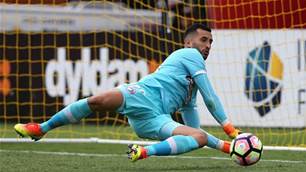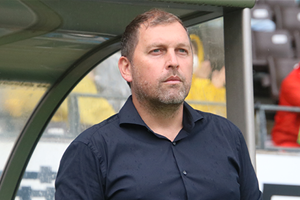While the 2020/21 A-League Grand Final ushers in a new era for Australian football, it also brings to an end a 15-year association with Fox Sports that has defined the rollercoaster nature of the sport.
In hindsight, it was a near-impossible ask.
In 2007, the A-League tried to take on established and unique sporting behemoths, in the world's most over-saturated sporting market, with a popularity boom that was almost entirely predicated on unsustainable Socceroos success.
Its partner on this ill-fated mission was a sports broadcaster that only reached 25% of the population, which had long and complicated ties to its much-larger competition.
But it's easy to overlook that when Fox Sports originally invested $120 million in the fledgling A-League competition for a seven-year deal, it instantly legitimised a brand-new Australian domestic football league.
It was such a stark contrast to the death knell of the NSL, when the competition had failed to find a broadcaster whatsoever.
Interest in the Socceroos was at an all-time high, and Fox Sports brought a level of polish and professionalism to football's coverage that SBS had never been financially equipped to muster.
A subscription broadcaster almost certainly limited the A-League's ability to reach a mainstream audience. But over the next few years, the competition appeared as if it could gradually challenge the NRL and AFL for sporting supremacy.
Marquees were generally successful, Melbourne Victory's average attendances were actively competing with the state's AFL clubs, and an unpredictable, salary-capped league brought a feel-good factor to the competition's smaller teams.
After failed expansion experimentation, when Western Sydney Wanderers were introduced to the competition in 2012, the A-League attracted a high of nearly 1.9 million fans through the gates in a single season.
While now it seems like an entitlement, for most of Fox Sports' reign, live coverage of every A-League, W-League, Matildas and Socceroos match would have been impossible with any other broadcaster. At its peak, Fox Sports' coverage regularly cost upwards of $40,000 per game.
But the sudden success of the Socceroos had plastered over numerous systemic issues and the infighting that had always plagued the sport's governance.
There was so much new content to sell a fragmented audience, that everything had to work perfectly in tandem and ultimately, almost nothing did.
So when the sport's flagship national team stagnated, so did public and media interest.
While early A-League grand final ratings proved lucrative, despite a much-publicised ratings slide, Fox Sports' average viewer numbers never reached the heights the organisation was hoping.
Between 2005 and 2018, the average ratings landed between 50-70,000 viewers 11 out of 13 times.
Fox Sports' simultaneous investment into AFL and NRL rights signalled that its dedication to football was always highly conditional, and that it simply couldn't rely on a sport so susceptible to a range of internal and external factors.
Until COVID-19 hit, the broadcaster's relationship with Australian football was almost bipolar.
On the one hand, Fox Sports started the process towards signing an improved six-year $346 million deal in 2016, despite three consecutive years of declining viewership.
On the other, it began to noticeably redirect spending on production and promotion towards its new sporting assets, even promoting rival sports throughout A-League broadcasts.
Beneath all of this, there was a much-maligned skewering of the free-to-air market by the broadcaster. The A-League's short spell on Channel 10 and its subsidiary networks was rendered a dismal failure, partly thanks to Fox Sports' 15% stake in the network.
But SBS' original four-year deal, meant to help broaden the competition's scope, proved just as lackadaisical.
Faced with poor ratings, SBS soon relegated the A-League to its own subsidiary network, and invested in English Premier League rights instead.
The end of The World Game simultaneously to Fox Sports, shows just how fickle the sport and broadcaster relationship really is.
But regardless of the football audience's view on Fox (and they've been quick to point out the mounting error count as production investment dwindled), the broadcaster was pivotal to ushering in a new era of professionalism in football coverage.
Post-match, Patrick Kisnorbo even compared the Fox Sports team's influence to Johnny Warren's. Like Warren, they'll never be able to truly say 'I told you so'.
The A-League clubs are now in the process of securing private equity funding to begin producing their own broadcast package, free of interference from opposing interests. For the first time, a future unbeholdent to broadcasters is on the horizon. But the involvement of private investment firms throw up an unfamiliar challenge to football around the world. It was these firms that almost destroyed the world's biggest football leagues for a cash-rich European Super League. If they can wreak havoc on the world's biggest football clubs, imagine how much sway they can have on the A-League.
So that's the way football on Fox ends, not with a bang or a whimper, but a grimace and a wave. As for Channel 10 and Paramount+....the king is dead, all hail the king.
End of an era today. To all my former Fox colleagues, on air & many off air, well done. Took the A-League, W-League, Socceroos, Matilda’s & the game in general to a new level. Now on to an exciting new chapter for ⚽️. 👏👏
— simonhill1894 (@simonhill1894) June 27, 2021
Related Articles

Socceroo-in-waiting seals Championship deal

Fringe Socceroo swerves A-League to remain in Europe after Fulham exit


















